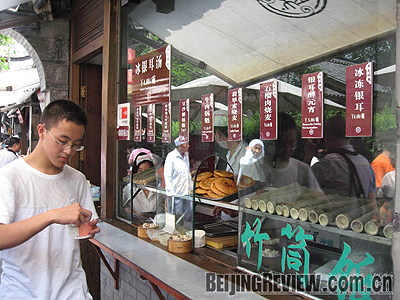|

EASY LIFE: The snack stands providing delicious local food along the street of Chengdu attract many people (JIANG WANDI)
After the catastrophic earthquake on May 12, whenever the name of Sichuan Province has been mentioned, the first scene in people's minds would be the scattered ruins, run-down houses, and desperate tears. Chengdu, as the capital city of the province, has become the center of the sad scene.
"After the earthquake, many people, when they came to Chengdu, would ask whether they should carry some water or food by themselves. Some even come here with several big boxes of purified water," said Zhou Mi, Vice Director of Chengdu Investment Promotion Commission, with a smile. "When they arrived here, they just realized that is not necessary at all."
Walking along the streets in the downtown area of Chengdu, you will find all the houses are still standing and perfectly safe. You can even be stuck by quite a few traffic jams in the downtown if you take a bus or taxi. At lunchtime or dinnertime, it is even difficult to get seats in the packed restaurants. Everything is just no different with what you can see in many other cities.
How, then, can Chengdu stand so well when some of the areas around it were damaged a lot?
"Chengdu survived due to its special strata texture, which absorbed most of the waves of the earthquake," said Cao Junxing, a geophysics professor of Chengdu University of Technology. "Just the special strata texture helps to ward Chengdu proper off being ruined by the earthquake. The rigidity of the strata becomes smaller and smaller from the bottom to the top, making its ability to absorb the seismic energy created by earthquakes stronger and stronger. This makes the seismic waves very weak with no destructive force when they spread to Chengdu."
"The solid construction of the houses also contributes to the safety here," said Yuan Zhongxiang, Director of the Housing Safety Evaluation Office of Chengdu Municipal House Property Administrative Bureau. "We started the evaluation of the houses in Chengdu proper at about 4 p.m. on May 12, just one and a half hours after the earthquake."
The result shows that less than 1 percent of the houses in Chengdu proper were destroyed, and no resident was killed or injured.
There are three county-level cities administrated by Chengdu damaged a lot by the earthquake-Dujiangyan, Chongzhou and Pengzhou. Due to the strong intensity of earthquake, Dujiangyan saw 20 percent of its houses collapse.
Normally the principle adhered to by all experts on post-earthquake work is to "save time for rescuing people, but take time for the reconstruction."
"But for the plan of this reconstruction, we have to make it out as soon as possible since the situation in the hit areas is very urgent," said Wang Songtao, Chief City Planner of Chengdu Planning Administrative Bureau.
A "Twin City Help Plan" was launched in order to provide more logistical help and support for the hit areas. Municipalities and cities in other areas of China will help the hit cities one by one during the reconstruction. According to the plan, Shanghai helps Dujiangyan, Chongqing helps Chongzhou, and Fuzhou, capital city of south China's Fujian Province, helps Pengzhou. These municipalities and cities are supposed to help the hit cities by not only providing materials but also organizing experts to make detailed reconstruction plans for them.
"The whole reconstruction plan is supposed to come out at the end of July, and the basic reconstruction work is supposed to finish in three years." Wang added.
Chengdu Planning Administrative Bureau has held three forums about the reconstruction, trying to get the real voice from experts and local residents. With so much to consider and so many challenges to meet, the reconstruction plan of Dujiangyan has already changed more than 40 times to meet the requirements of local residents. The planners are intent on not just re-housing, but recreating with new improvements to the area.
"Except for a few towns along Longmen Mountains that were totally destroyed by the earthquake, I can say that we can make the reconstruction of the original places of all the other hit areas," said Wang.
Along with the reconstruction, there are many forums and meetings held in Chengdu to attract more attention and show more people that Chengdu is still a safe city. "It is very important to rebuild people's confidence and remove their safety concerns," said Zhou.
| 